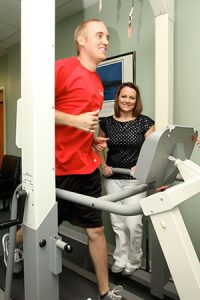Written by Steph Heinatz
—
The inspiration is everywhere—runners bragging about that “high” they feel after finishing an hour or two of pounding the pavement, Pinterest photos of a sleek runner with the tagline, “If you run, you’re a runner,” “When your legs get tired, run with your heart,” or “My sport is your sport’s punishment.”
Now you have the bug. Perhaps you want to try out your first 5K-distance race or increase your mileage and graduate from a 10K to a half or full marathon.
No matter your running goals, or target distance, understanding how your body moves and how to train it to run for 30, 90 or 180 minutes straight is your first step.
5, 8 and 10Ks – oh, my!
So you want to train for your first 5 or 10K race? It’s not as difficult as you might think, says endurance athlete and physical therapist Matthew Ammons.
“Depending on your prior level of experience and physical activity level, training for your first 5K or 10K can be a rewarding experience,” says Ammons, who works with runners in the Virginia Beach, Va., Tidewater Physical Therapy location where he serves as the clinical director. “For runners new to the sport, begin with a walk-to-run program that allows for gradual progression in mileage to ward off injuries and to gain confidence in your new activity.”
Plan on giving yourself eight to 12 weeks to work up from walking to running.
“You want to give your body time to adapt to the physical loads that occur during running,” Ammons says. “By using an eight-to-12 week program, you are also allowing for other physiological changes to occur — increasing aerobic capacity and muscular endurance.”
“Don’t think you have to run on consecutive days,” says Mike Satterley, Director of Sports Therapy Programs at Tidewater Physical Therapy’s Oyster Point location in Newport News, Va.
“Focus on one longer run and a few shorter runs each week.”
Half-Marathons: “Because I’m Only Half Crazy.”
An evaluation of strength, flexibility and foot type may be beneficial for runners setting out on their first half-marathon training program, says Kristina Carter, a senior physical therapist with Tidewater Physical Therapy in Williamsburg, Va., who’s completed “more half marathons than I can count.”
Why?
“Basically, you can get away with strength deficits, poor flexibility or a funky foot if you are doing a shorter distance like a 5K,” Carter explains. “But when you add more training and increase distance, these deficits catch up to you.”
Getting the right gear is key to reaching that half-marathon finish line, says Andrea Lehmkuhler, who manages Point 2 Running Company in Newport News.
Point 2 Running Company fits runners with shoes based on the measurement of their feet, arch types, pressure points and overall gait style, or measure of pronation.
“A pair of properly fitted shoes are the cornerstone of any good running training regimen,” Lehmkuhler says. “Beyond that, we recommend having a few pairs of high-quality, moisture-wicking socks and a good pair of compression sleeves to quicken recovery time and even help with shin splints.”
Going the Distance: Marathons
First things first—think injury prevention. Twenty-six miles is a long way to run. If you’re looking at your first marathon, be sure you’ve been running for at least one year before kicking off your training program, says Karen Kovacs, a USA Triathlon Level 1 coach, physical therapist and clinical director of the Tidewater Physical Therapy location at Gloucester Point, Va.
“This allows you an opportunity to gradually build up mileage to avoid injury,” she says. “Try out shorter distances like a 10K or half-marathon before committing to a 26.2-mile event.”
Not only will it help in your training, but it will also give you a base to “determine a realistic pace so that you can plan your training schedule,” Kovacs says. “Training for a marathon requires a big time commitment and trying out the shorter distances will give you a feel for the impact the training will have on your personal, family and work time.”
Decide on a specific marathon and then mark it big and bright on the calendar. Be sure you pick a race that’s at least 16 to 24 weeks out so you have time to layer in your training.
The Peninsula Track Club in Newport News and Colonial Road Runners in Williamsburg offer online training plans and guidance from expert coaches.
Kovacs advises against increasing your weekly mileage or longest run by more than 10 percent each time to help prevent injury.
“Long training runs need to be balanced with adequate time for recovery,” Kovacs says.
Don’t forget to consider nutrition and hydration in your training.
“Marathon sponsors often post online what electrolyte replacement beverage they will serve at the race,” Kovacs says. “If you plan to drink that, be sure to try that particular brand during your training to be certain your stomach will tolerate it without distress.”
Whenever possible, try to simulate the conditions you will experience at your marathon in your training—running in the rain, humidity and on hills.
“Don’t try anything new on race day that you haven’t tried in training,” Kovacs instructs. “No matter what distance you are running, you want to plan your race and race your plan.”
Set your goals now! Register for a local race!
Trailzilla Race Series
- 4-Miler on Tuesday, July 9 at 6:30 p.m. and a 6-Miler on Saturday, July 20 at 9 a.m.
- Sandy Bottom Nature Park in Hampton, Va.
- http://eventful.com/hampton/events/trailzilla-race-series-4-miler-/E0-001-013414307-8
Coast Guard Day 5K
- Saturday, July 27 at 8:30 a.m.
- Coast Guard Training Center, Yorktown, Va.
- http://www.uscg.mil/tcyorktown/Support/MWR/5k.asp
Mulberry Island Half Marathon & 5K Runs
- Saturday, Sept. 21 at 7:30 a.m.
- Fort Eustis, Newport News, Va.
- http://www.runwashington.com/calendar/details.php?race=12792
12th Annual Smithfield Hog Jog 5K
- Saturday, Oct. 12 at 9 a.m.
- Smithfield, Va.
- http://www.active.com/running/smithfield-va/12th-annual-smithfield-hog-jog-2013
13th Annual 10K on the Noland Trail & 5K at the Park
- Saturday, Oct. 19
- Mariners’ Museum, Newport News, Va.
- http://www.runwashington.com/calendar/details.php?race=12796
Yorktown Battlefield 10 Miler & 5K
- Saturday, Nov. 2 at 8:45 a.m.
- York High School, Yorktown, Va.
- http://www.runwashington.com/calendar/details.php?race=12798
Virginia Running Festival (Half Marathon & 5K)
- Sunday, Nov. 10
- Christopher Newport University, Newport News, Va.
- http://www.virginiarunningfestival.com/
Anthem Richmond Marathon “America’s Friendliest Marathon”
- Saturday, Nov. 16
- Richmond, Va.
- http://www.richmondmarathon.com/
Blue Talon Bistro Turkey Trot 5K & Kid’s 1-Miler
- Thursday, Nov. 28
- Williamsburg, Va.
- http://www.btb5k.mettleevents.com/
Christmas Town Dash 8K
- Sunday, Dec. 8 at 8:30 a.m.
- Busch Gardens, Williamsburg, Va.
- http://www.christmastowndash.com/



